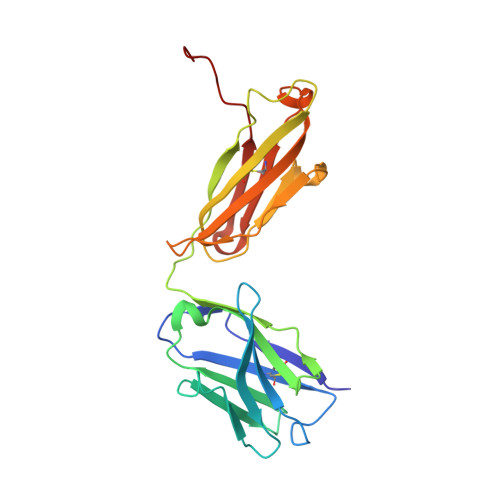Structure guided maturation of a novel humanized anti-HBV antibody and its preclinical development.
Zhou, B., Xia, L., Zhang, T., You, M., Huang, Y., He, M., Su, R., Tang, J., Zhang, J., Li, S., An, Z., Yuan, Q., Luo, W., Xia, N.(2020) Antiviral Res 180: 104757-104757
- PubMed: 32171857
- DOI: https://doi.org/10.1016/j.antiviral.2020.104757
- Primary Citation of Related Structures:
6L8T - PubMed Abstract:
We have reported that E6F6, a mouse monoclonal antibody, is a promising treatment option for patients with chronic hepatitis B (CHB). A humanized E6F6 antibody B11 with affinity loss was obtained by CDR-grafting approach. To address this issue, in silico affinity maturation through scanning mutagenesis using CHARMM force field methods was performed on an predicted immune complex model of the B11:HBsAg. We chose four variants with top increased interaction energy for further characterization. The antibody huE6F6-1 within two point mutations (Heavy Chain: Asp65Val; His66Leu) was identified to restore the parental antibody's high binding affinity, neutralization activity, and potent efficacy of viral suppression in vivo. Crystal structure (1.8 Å resolution) based molecular docking proved more stabilized and compact hydrogen bond interactions formed in huE6F6-1.The smaller and dispersed HBV immune complexes of huE6F6-1 by electron microscopy suggested it will have the same therapeutic efficacy as the parental E6F6 mAb. Preclinical study and pharmacokinetics of huE6F6-1 demonstrated that it is a stable and desirable lead candidate to improve the clinical management of CHB. Notably, our structure guided approach may facilitate the humanization and affinity maturation of other rodent antibody candidates during drug development.
Organizational Affiliation:
State Key Laboratory of Molecular Vaccinology and Molecular Diagnostics, National Institute of Diagnostics and Vaccine Development in Infectious Diseases, School of Public Health, School of Life Science, Xiamen University; Xiamen, 361105, China; The 2nd Affiliated Hospital, South University of Science and Technology, 29 Bulan Road, Longgang District, Shenzhen, 518112, China.















